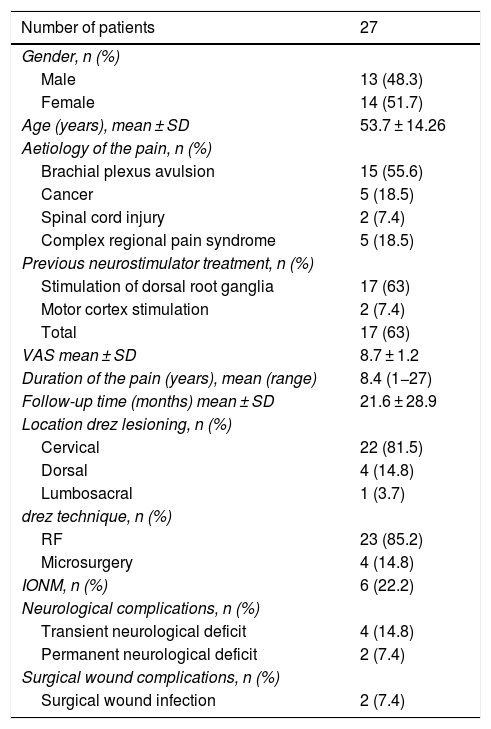The treatment of deafferentation pain by spinal DREZotomy is a proven therapeutic option in the literature. In recent years, use of DREZotomy has been relegated to second place due to the emergence of neuromodulation therapies. The objectives of this study are to demonstrate that DREZotomy continues to be an effective and safe treatment and to analyse predictive factors for success.
Patients and methodsA retrospective study was conducted of all patients treated in our department with spinal DREZotomy from 1998 to 2018. Bulbar DREZotomy procedures were excluded. A visual analogue scale (VAS) and the reduction of routine medication were used as outcome variables. Demographic, clinical and operative variables were analysed as predictive factors for success.
ResultsA total of 27 patients (51.9% female) with a mean age of 53.7 years underwent DREZotomy. The main cause of pain was brachial plexus injury (BPI) (55.6%) followed by neoplasms (18.5%). The mean time of pain evolution was 8.4 years with a mean intensity of 8.7 according to the VAS, even though 63% of the patients had previously received neurostimulation therapy. Favourable outcome (≥50% pain reduction in the VAS) was observed in 77.8% of patients during the postoperative period and remained in 59.3% of patients after 22 months average follow-up (mean reduction of 4.9 points). This allowed for a reduction in routine analgesic treatment in 70.4% of them. DREZotomy in BPI-related pain presented a significantly higher success rate (93%) than the other pathologies (41.7%) (p = 0.001). No association was observed between outcome and age, gender, DREZ technique, duration of pain or previous neurostimulation therapies. There were six neurological complications, four post-operative transient neurological deficits and two permanent deficits.
ConclusionDorsal root entry zone surgery is effective and safe for treating patients with deafferentation pain, especially after brachial plexus injury. It can be considered an alternative treatment after failed neurostimulation techniques for pain control. However, its indication should be considered as the first therapeutic option after medical therapy failure due to its good long-term results.
El tratamiento del dolor por desaferentización mediante drezotomía espinal es una opción terapéutica contrastada en la literatura. En los últimos años, la drezotomía ha visto relegado su empleo a un segundo plano debido a la eclosión de las terapias neuromoduladoras. Los objetivos de este estudio son demostrar que la drezotomía continua siendo un tratamiento efectivo y seguro y analizar aquellos factores predictores de éxito.
Pacientes y métodosSe realizó un estudio retrospectivo de todos los pacientes tratados en nuestro servicio mediante drezotomía espinal desde 1998 hasta 2018. Se excluyeron los casos de drezotomía bulbar. Se emplearon la escala visual analógica (EVA) y la reducción de la medicación habitual como variables resultado y se analizaron variables demográficas, clínicas y quirúrgicas como factores predictores de éxito.
ResultadosUn total de 27 pacientes (51,9% mujeres) de 53,7 años de edad media fueron tratados mediante drezotomía. La etiología principal del dolor fue por avulsión de plexo braquial (55,6%) seguida de causa tumoral (18,5%). El tiempo medio de evolución del dolor fue de 8,4 años con una intensidad media de 8,7 según la EVA pese a que el 63% de los pacientes habían recibido tratamiento neuroestimulador previo. Durante el postoperatorio inmediato un 77,8% de los pacientes presentaron una reducción del 50% o más en la EVA. Tras un seguimiento medio de 22 meses postdrezotomía permaneció una reducción de al menos el 50% en la EVA en el 59,3% de los pacientes (reducción media de 4,9 puntos) permitiendo una reducción del tratamiento analgésico habitual en el 70,4% de ellos. La drezotomía en la avulsión de plexo braquial presentó una tasa de éxito (93%) superior al resto de patologías (41,7%) de manera significativa (p = 0,001). La edad, el sexo, la técnica DREZ, el tiempo de evolución y el antecedente de tratamiento con neuroestimulador no demostraron ser factores pronósticos. Como complicaciones 4 pacientes presentaron déficit neurológico transitorio postoperatorio y 2 déficit permanente.
ConclusiónLa drezotomía espinal es un tratamiento efectivo y seguro en pacientes con dolor por desaferentización especialmente en la avulsión de plexo braquial. Se ha demostrado su utilidad tras el fracaso de las técnicas neuroestimuladoras para el control del dolor, pero debe considerarse su indicación como primera opción terapéutica tras el fracaso del tratamiento farmacológico dados los buenos resultados mantenidos a largo plazo.
Article

If it is the first time you have accessed you can obtain your credentials by contacting Elsevier Spain in suscripciones@elsevier.com or by calling our Customer Service at902 88 87 40 if you are calling from Spain or at +34 932 418 800 (from 9 to 18h., GMT + 1) if you are calling outside of Spain.
If you already have your login data, please click here .
If you have forgotten your password you can you can recover it by clicking here and selecting the option ¿I have forgotten my password¿.











